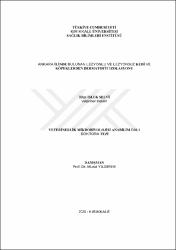| dc.contributor.advisor | Yıldırım, Murat | |
| dc.contributor.author | Selvi, Bilge İşlek | |
| dc.date.accessioned | 2021-01-16T19:03:51Z | |
| dc.date.available | 2021-01-16T19:03:51Z | |
| dc.date.issued | 2020 | |
| dc.identifier.uri | | |
| dc.identifier.uri | https://hdl.handle.net/20.500.12587/15840 | |
| dc.description | YÖK Tez ID: 637604 | en_US |
| dc.description.abstract | Bu çalışmada, Ankara ilinde dermatofitozis şüpheli lezyonlu ve lezyonsuz kedi ve köpeklerden Mackenzie diş fırçası tekniğiyle kıl ve tüy örneklerinin toplanması, bu örneklerin direkt mikroskobik incelemesinin ve kültür yöntemiyle etken izolasyonunun yapılması amaçlandı. Elde edilen bulguların örnek toplanan hayvanların cinsiyet, ırk, yaş, tür, yaşam alanı, sahiplilik durumu ve örneklerin toplandığı mevsimler ile ilişkisi incelendi. Yaz ve sonbahar mevsimlerinde toplanan örneklerin direkt mikroskopisinde ışık mikroskobunun yanı sıra floresan mikroskobu da kullanıldı. Calcofluor White ile yapılan floresan mikroskopisinin KOH ile yapılan ışık mikroskopisine göre sensitivite ve spesifite bakımından karşılaştırıldığında daha yüksek olduğu görüldü. Bu tez çalışmasında kedi ve köpeklerden alınan toplam 240 materyal dermatofitozis yönünden incelendi. Kültür işlemi sonrasında 65 materyalden (%27.08) dermatofit izole edildi. Dermatofit Test Besiyerinde (DTM), Sabouraud Dekstroz Agar'a (SDA) göre daha yüksek oranda dermatofit izole edildi. Kedi materyallerinden izole edilen dermatofit türlerinin %18.91'i M. nanum, %18.91'i M. gypseum, %18.91'i T. mentagrophytes, %24.32'si M. canis, %13.51'i T verrucosum, %5.4'ü T. rubrum olarak identifiye edildi. Köpek materyallerinden izole edilen dermatofit türleri ise %17.85'i M. nanum, %14.28'i M. canis, %14.28'i M. gypseum, %28.57'si T. mentagrophytes, %14.28'i T. verrucosum, %7.14'ü T. rubrum, %3.57'si T. terrestre olarak identifiye edildi. İzole edilen dermatofit türlerinin hemolitik aktiviteleri değerlendirildi. Ayrıca, dermatofitozis olgularında cinsiyet yatkınlığının olmadığı belirlendi. Lezyonlu ve lezyonsuz köpeklerde dermatofit izolasyonu yakın oranlarda seyrederken, lezyonsuz kedilerde lezyonlu kedilere göre daha yüksek oranda dermatofit izole edildi. Ancak bu bulguların istatistiki olarak anlamlı olmadığı görüldü (P>0.05). Sonuç olarak yaş aralıklarının, mevsimlerin, hayvanların yaşadıkları yerlerin, sahiplilik sahipsizlik durumlarının dermatofit izolasyonu ile anlamlı bir ilişkisi olmadığı kanaatine varıldı. | en_US |
| dc.description.abstract | In this thesis study hair samples were collected from cats and dogs with or without dermatophytosis suspicious lesions in Ankara using the Mackenzie toothbrush technique. Direct microscopic examination of these samples is done with light microscopy and agent isolation was performed by culture method. The relation of the obtained findings with the gender, race, age, species, habitat, ownership status of the animals, and the seasons in which the samples were collected were examined. In addition to light microscopy, fluorescence microscopy was also used in direct microscopy of the samples collected in the summer and autumn seasons. Fluorescence microscopy with Calcofluor White was found to has higher percentages when compared to light microscopy with KOH in terms of sensitivity and specificity. In this thesis, a total of 240 materials from cats and dogs were examined for dermatophytosis. Dermatophyte was isolated from 65 materials (27.08%) after culturing. Dermatophyte were isolated in Dermatophyte Test Medium (DTM) in higher rates than Sabouraud Dextrose Agar (SDA). Dermatophyte species isolated from cat materials were identified as 18.91% M. nanum, 18.91% M. gypseum, 18.91% T. mentagrophytes, 24.32% M. canis, 13.51% T verrucosum, 5.4% T. rubrum. Dermatophyte species isolated from dog materials were identified as 17.85% M. nanum, 14.28% M. canis, 14.28% M. gypseum, 28.57% T. mentagrophytes, 14.28% T. verrucosum, 7.14% T. rubrum, 3.57% T. terrestre. Hemolytic activities of isolated dermatophytes were evaluated. In this thesis, it was determined that there was no gender predisposition in dermatophytosis cases. While dermatophyte isolation was observed at close rates in dogs with lesion and without lesion, a higher rate of dermatophyte was isolated in cats without lesion than cats with lesion. However, these findings were not statistically significant (P> 0.05). As a result of the findings, it was concluded that age ranges, seasons, habitat, and ownership status do not have a significant relationship with dermatophyte isolation. | en_US |
| dc.language.iso | tur | en_US |
| dc.publisher | Kırıkkale Üniversitesi | en_US |
| dc.rights | info:eu-repo/semantics/openAccess | en_US |
| dc.subject | Mikrobiyoloji | en_US |
| dc.subject | Microbiology ; Veteriner Hekimliği | en_US |
| dc.subject | Veterinary Medicine | en_US |
| dc.subject | | en_US |
| dc.subject | | en_US |
| dc.subject | | en_US |
| dc.title | Ankara ilinde bulunan lezyonlu ve lezyonsuz kedi ve köpeklerden dermatofit izolasyonu | en_US |
| dc.title.alternative | Isolation of dermatophyte from cats and dogs with lesion and without lesion in Ankara province | en_US |
| dc.type | doctoralThesis | en_US |
| dc.contributor.department | KKÜ, Sağlık Bilimleri Enstitüsü, Mikrobiyoloji (Veterinerlik) Anabilim Dalı | en_US |
| dc.identifier.startpage | 1 | en_US |
| dc.identifier.endpage | 81 | en_US |
| dc.relation.publicationcategory | Tez | en_US |
















